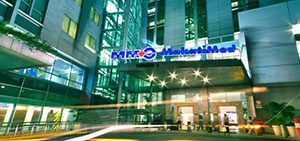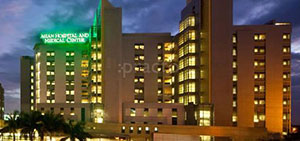Paola T. Paska
In October 2012, I underwent a total hysterectomy via robotic surgery at St. Luke’s Medical Center – Global City, just 5 weeks after being diagnosed with multiple myomas and advised that the surgery was the best course of action.
Before making my final decision, I sought opinions from 3 other doctors – not out of mistrust or lack of respect for their expertise, but simply in the hopes of avoiding surgery altogether. Their advice was sympathetic and concerned that I would be saddened about losing the ability to have children. But what really rang in my ears was the fact that I needed to have a major organ surgically removed!
Despite all of their assurances and my own research online that emphasized how common myomas are in adult women, the straightforward clinical explanations simply couldn’t soothe my anxiety. I was concerned about cost – how much would the surgery and several days of hospitalization cost? As a freelance writer, I did not have a steady salary and paid leave to help financially, so when could I return to work?
Most of all, I worried about the physical pain, especially with the possibility of traditional surgery involving a rather large midline incision, andabout recovery. I readily admit to having an extremely low tolerance for pain and I considered kicking the problem down the road. Ignore it and there’s nothing to worry about, right?
The turning point came when I read an article written by Dr. Rebecca Singson shortly after my diagnosis. In it, she clearly and simply explained the benefits of robotic-assisted surgery, including the reductions in pain, surgical risks and recovery period.
The price tag was an initial concern, which meant that my husband and I would have to dip into our savings. But it came down to a simple thought – what is the value of peace of mind? To answer this question, I considered several things:
The time value of cost. We all have busy lives – families to nurture, careers and businesses to tend, friends and activities to enjoy. To me, the prospect of returning to regular life in a matter of weeks, not months, was appealing.
The emotional value of cost. I was not the only one who had anxieties and concerns about surgery; my husband and my parents were also worried for me. The reduced risks involved in minimally invasive surgery went a long way toward soothing all of our worries.
Considering these points in combination with what I learned about robotic surgery after consulting directly with Dr. Singson, I felt more comfortable and confident about my decision to proceed with the operation.
Looking back at my experience, I cannot say enough about how happy I am with my decision! One moment, I was staring at the lights after being wheeled into the operating room and then next, I was blinking up at the OR nurse telling me that all went well. Back in my room a few hours later, I experienced some discomfort but no pain and I was walking around the hallways the following day. Less than 48 hours after surgery, I was back at home.
The only negative thing to be said about the near-total lack of pain is that it was all too easy to forget I had undergone major surgery. As such, in the ensuing days, I sometimes pushed ahead of what was physically allowed and had to dial down my activities to allow myself to heal properly. It was a reminder that the risks and side effects of major surgery are minimized, not eliminated, with robotic assistance.
I realize that not all experiences will be exactly like mine and that much is dependent on each person’s own condition and history. What we all share, however, are the same worries and fears – of pain, of risk, of negative outcomes. Often, those worries and fears of what might happen may lead us to avoid making the best decisions for our own health and well-being.
I am grateful that state-of-the-art technology and abundant information was available to help me make what was definitely the right decision for my health. I am extremely grateful that Dr. Singson and her colleagues, and institutions like St. Luke’s have made the investment in training and equipment in order to make these procedures available to patients and give us access to the resources that will help us live long, healthy and active lives.
RoboDoc by Philippine Star

She looks far from a female Arnold Schwarzenegger, but probably has all the amazing skills of a RoboCop’s counterpart in the Operating Room.
Dr. Rebecca Singson doesn’t just deliver babies. She delivers results — on the operating table, in the delivery room, on the driving range. Even in parties, she delivers — with one or two song numbers. You see, while pursuing her pre-med course at the University of the Philippines, she cross-enrolled at the College of Music. (Later on, she would get her own clinic at the Makati Medical Center for a song — literally. Dr. Rebecco Panlilio, a music lover, heard her sing at one gathering of doctors and told her she could use his MMC clinic since he was then not very active with his practice.)
Today, 22 years after graduating from medical school, Becky is one of two internationally accredited robotics surgeons in the Philippines.
Beautiful Becky pays as much attention to her looks (“Never, ever, give up your happy hormones,” she counsels) as to her skills.
“I will never stop searching for better ways to do things,” says Becky, who is the chairperson of the Department of Obstetrics and Gynecology and head of the Gyne-Robotic Surgery Section of St. Luke’s Medical Center in Taguig. “This is the way I always operate. If there’s a better way to do it, I will find it. It would be such a pity not to be able to offer to Filipinos a treatment that they can access abroad. Why would they have to go abroad for Robotics Surgery, when they can have it here?”
Becky’s robot is nicknamed “Da Vinci,” from the Da Vinci Surgical System. Only St. Luke’s has the four-armed Da Vinci SI robot in the country.
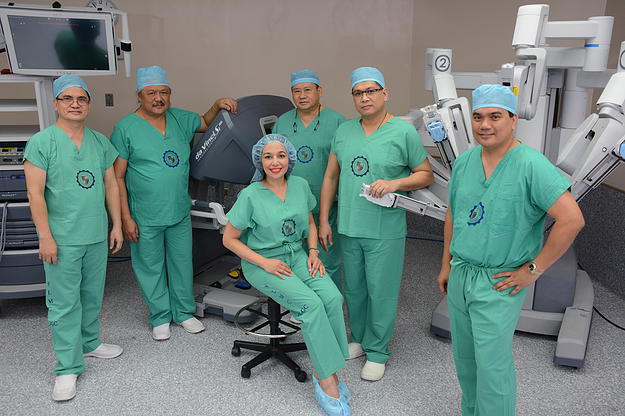
Singson heads the Gyne-Robotic Surgery Section of St. Luke’s in Taguig.
Over Moroccan coffee, she shares the advantages of Robotics Surgery over traditional approaches. “Small incisions and therefore minimal to invisible scarring and significantly less pain because the wounds are so small a Band-Aid can cover them. There is minimal blood loss and need for transfusion and fewer complications, such as post-operative adhesions because there is less manipulation and injury to tissues.”
The best part, to most patients, is the shorter hospital stay, which is reduced to 24 to 48 hours after surgery, from four to five days’ confinement.
“Patients have quicker recovery and may return to normal activities and even return to work within a week, whereas in the past, there was four to eight weeks’ downtime.”
Becky says that the quicker recovery after Robotics Surgery has taken the fear out of surgery for many patients. In the past, some patients would rather have a growth (even those twice as big as a baby’s head) fester in their abdomen than undergo surgery because they feared its complications.
“Empowering women is my advocacy,” says this happily married mother of two young adults. “I want to get the message out there. Women need to know the options available to them. They don’t need to live in frustration or live with fear of surgery. They realize that with Robotics, surgery isn’t so daunting after all.”
Becky makes sure she works with a select group of anesthesiologists “who are very well versed on procedure and on the quirks that can happen. They have to be on my phone so we can always confer.”
Becky recommends Robotics Surgery for ovarian cysts and difficult endometriosis surgery, which can be performed with greater precision.
“Microsurgery for tubal surgery and complex hysterectomies can be better accomplished since fine movements and fine suturing can be accomplished. Robotics Surgery has a place particularly in cancer surgery where, conventionally, the surgeon is required to stand from four to even for as long as nine hours for one surgery.”
The morbidity rate for Robotics is only 0.2 percent, so to a layman, that means a success rate of 99.8 percent.
Robotics, however, isn’t performed for childbirth because the incision is so small, no baby can fit through it.
“I like to refine things,” says Becky, who earned a degree in BS Biology from UP, magna cum laude, and was one of the Top 10 women graduates of her batch at the UP College of Medicine. She also likes to make things easy for women. For childbirth without complications, she recommends a full diet right away, for instance. She sends patients home when they can already walk to the bathroom by themselves.
Ysabel Balagot

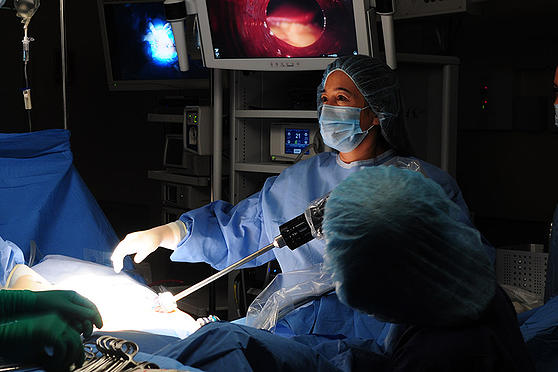
Finding out that I needed surgery came out of the blue for me. It was a few days before my 19th birthday and I came in for a check-up for a totally different thing. I found a lump at the back of my ear and my right nipple started to have a pinching kind of pain. The OB-Gyn that I first went to then advised me to take some tests including a transrectal ultrasound. They found two benign cysts—one on each ovary. One was 5cm and the other was 8cm. It all came as a shock because I felt completely normal aside from the pain I was complaining about in the first place. I was even physically active in school the week before.
The doctor then advised me to undergo open surgery as soon as possible. Already crying, I did not know what to do. She said that it had to be open surgery because of the size of the cysts. So in short, I had no choice. If not attended to right away, it could cause serious damage to my ovaries. We then scheduled the surgery.
Leaving the hospital, my parents and I could not believe what just happened. They wanted to get a second opinion so I got another transrectal ultrasound elsewhere and got the same results. Being certain now of the results, my parents and relatives still wanted to get a second opinion about the surgery.
Referred to by one of their friends, I went in to see Dra. Rebecca Singson in St. Luke’s Medical Center in the Fort. She told us about another option, which was relatively new in the Philippines—robotics surgery. At first I was asking all sorts of questions when she said that she would only have to cut 4 approximately 1-inch incisions. How were 5cm and 8cm cysts going to fit through a 1-inch hole? She then explained how the procedure goes and said that she has done it many times in the past for different kinds of cysts. She said it was a less invasive kind of surgery and even more accurate than a laparoscopy. Persuaded, we scheduled the surgery.
Doing more research and weighing in the pros and cons of both types of surgery, we then canceled the first one. On February 13, 2013, a Wednesday, I was admitted in St. Luke’s and had my surgery at around 6pm that night and was back in my room by around 1am the next day. When I woke up, I could already talk a little and was placed on a soft diet. It was quite painful to laugh though as my visitors would always try to. They took me out of morphine after two days and I just had oral medication to help with the pain. Although more than the pain of the incisions, I complained more about the gas pains I felt due to the gas they used during the surgery.
I stayed in till Saturday morning as my doctor even joked that I was already overstaying in the hospital since her 89-year old patient stayed even shorter than I did. It then took me less than a week to go back to school. I went back that Tuesday and was able to catch-up on the things that I missed, especially since it was exam week. It was still pretty difficult to walk my normal pace but I managed to go up and down the stairs to the 3rd floor of my building. The next few days became easier and things slowly went back to normal. The pain slowly disappeared as well.
Now that it’s been around 2 months since the surgery, I am feeling as fine as ever. I’ve already resumed to my usual activities and have even done some physical exercises as well. Choosing the robotics surgery was a really good decision for me. Open surgery would have been more invasive which would have required me to stay longer in the hospital and hinder me from going back to school right away and catch up on things as quickly as I did. I feel very lucky to have been able to have undergone this kind of surgery and fully recover.
– Ysabel Balagot, 19 years old
Robotic surgery a sci-fi dream now a reality

You’d think robotics in surgery was just a scene in a science fiction movie. But no, the technology is now a reality. Robotic surgery is a breakthrough surgical technology which raises the bar of surgical management in the Philippines with a new category of minimally invasive surgery in the country.
What is robotic surgery?
Yes, it’s exactly how it sounds. It is the use of robots in performing surgeries.
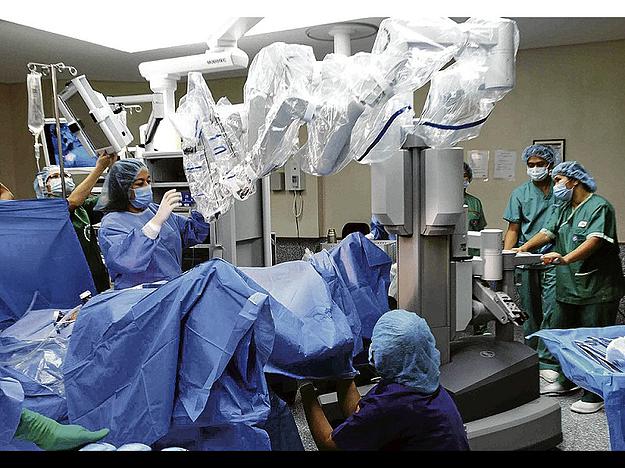
The Da Vinci Surgical System is a sophisticated robotic setup capable of expanding the operator’s surgical skills, allowing the surgeon to operate with unmatched accuracy, vision and control. Furthermore, the surgeon can offer a minimally invasive option which is far more precise than laparoscopic surgery, in place of a major traditional surgery.
The Da Vinci robotic system is made up of 3 main components: a surgeon’s console; a patient-side robotic cart with 4 arms manipulated by the surgeon (one to control the camera and three to manipulate instruments); and a high-definition 3D visual system that allows the surgeon to see the operative field in stereoscopic vision.
In performing robotic surgery, the surgeon is relaxed sitting in the console from where he can see a magnified, high-resolution three-dimensional image of the part of the body to be operated on. Instead of the traditional 50-100 mm large incisions with conventional surgery, with robotic surgery, miniaturized, wristed instruments are introduced through small incisions ranging from 5 to 12 mm and allows the surgeon to see the surgical site in true stereoscopic vision, at 10-12 times more magnified than the naked eye can see. This allows the surgeon a better view of blood vessels and nerves that need to be avoided or dissected out.
Furthermore, the robotic and computer technologies combine to sense the surgeon’s hand movements and scales it to seamlessly and electronically translate the surgeon’s hand movements into precise micro-movements. It also filters out any tremors in the surgeon’s hands so they will not manifest in the robotic instruments. Contrary to your fears that the robot might run amuck, the system cannot move by itself nor can it decide for itself but requires that every move be performed through the direct manipulation by the surgeon.
The system is named after Leonardo da Vinci who invented the first robot. He was the artist who created masterpieces drawn with unparalleled anatomical accuracy and three-dimensional details. The Da Vinci Surgical System similarly provides physicians with such enhanced detail and precision that the system can simulate the process of a traditional open surgery while allowing operation through tiny incisions.
- Robotic surgery offers several potential benefits over traditional approaches, including:
- Small incisions and therefore minimal to invisible scarring;
- Significantly less pain because the wounds are so small a band-aid can cover them;
- Minimal blood loss and need for transfusion;
- Fewer complications, such as post-operative adhesions because there is less manipulation and injury to tissues; or inadvertent damage to normal vessels and nerves due to higher magnification of structures;
- Shorter hospital stay which is reduced from 24 to 48 hours for a surgery that used to have a 4-5 day stay;
- Quicker recovery and return to normal activities – return to work within a week with a surgery that used to take 4-8 weeks downtime;
- Better outcomes and patient satisfaction;
More comfortable and less muscle fatigue for the surgeon who is seated throughout the surgery performing the surgery from the console as opposed to standing for 5 hours or more in performing a difficult cancer surgery.
Among its most popular applications are surgeries in the following fields:
- Cardiothoracic – coronary artery bypass, coronary stenting, mitral valve repairs and replacement, esophagectomy, lung resection, tumor resections;
- General surgery – all general surgical procedures including cancer surgery and bariatric surgery;
- Gynecology – removal of ovarian cysts, endometriosis, myomectomy, uterine prolapsed, hysterectomy, pelvic cancer surgery; and
- Urology – removal of the prostate gland for cancer, repair of obstructed kidneys, repair bladder abnormalities and remove diseased kidneys, kidney transplants.
In the Philippines, where surgeons, urologists and gynecologists are just beginning to embrace laparoscopic surgery, it’s awesome to think that the sci-fi dream of robotic surgery is now a reality and will once more make us at par with surgical treatments that once upon a time, were only available in first world countries.
Read more: http://business.inquirer.net/5118/robotic-surgery-a-sci-fi-dream-now-a-reality#ixzz3LNiLjW1g
Follow us: @inquirerdotnet on Twitter | inquirerdotnet on Facebook
Dr. Rebecca Singson-Zahar on healthy living, loving, and babies
I will never do things the way it’s always been done just because people have always done it that way. If there’s a better way to do it, I will try to find it.”
Dr. Rebecca “Becky” Singson-Zahar, chairperson of the Department of Obstetrics and Gynecology at St. Luke’s Medical Center Global City, lives by this principle. A visit to Dr. Becky, with her exuberant personality and friendly pieces of advice, is an unforgettable breath of fresh air. A departure from the image of a stereotypical doctor who fixates on a specific medical condition, Dr. Becky goes above and beyond the call of medical duties as an ob-gyne. Dr. Becky, a strong advocate of healthy living and maternal care issues, teaches patients how to eat right, exercise, and rest. A certified travelbug, Dr. Becky will also throw in a free bonus lecture or story about her travels.
One can spot Dr. Becky a mile away, thanks to her signature bright outfits with a matching sunny smile. Nurses and hospital staff at the OB section of St. Luke’s Global agree that Dr. Becky is one of the top baby deliverers and the go-to person, especially in emergencies and tough judgment calls.
No stranger to hard work, Dr. Becky graduated magna cum laude from the University of the Philippines. She then went to the UP College of Medicine, where she was in the top 10 of her graduating class. After that, Dr. Becky trained at Makati Medical Center under the late Dr. Constantino Manahan. The alumni of St. Pedro Poveda College recently bestowed Dr. Becky with the first Povedans Outstanding in Work Ethics and Reforms (Power) award for her contributions in the field of health.
This doctor is a multi-talented woman whose own life’s love story is enough to rival any romantic movie. Dr. Becky, fluent in Italian herself, is married to the dashing Luciano Zahar who works at the University of Trieste, Italy. It’s the family’s custom for Luciano to fly to Manila for winter, and for Dr. Becky and the kids to fly to Italy for summer. An artist, singer, golfer, devoted mother to gorgeous 17-year-old twins Giovanni and Giulia, Dr. Becky shares her work, her life, and her loves. Excerpts:
PHILIPPINE STAR: You have a different mural on the walls of each of your clinics. Why so?
Lifestyle Feature ( Article MRec ), pagematch: 1, sectionmatch:
DR. BECKY SINGSON-ZAHAR: The wall murals in my clinic were done by the painter Milan Pilares. He’s so good! All my clinics have an Italian theme as it makes me feel as if I’m in Italy all year round. Plus, I don’t want my clinics to feel like sterile clinics. I want my patients to feel well since most of them are healthy anyway. Majority of them are either pregnant, or having a Pap smear and regular checkup.
At Makati Med, the mural is of my husband’s place — landmarks of his town, places where he swam in and grew up in. Asian Hospital’s mural is of an Italian renaissance garden — with fields, meadows, fountains, and statues. At St. Luke’s Global, I decided on Venice as it’s very close to my heart. We fly to Venice every year, and it’s where my husband Luciano picks us up.
When did you know that you wanted to be a doctor?
My mom was a frustrated doctor. When I was young, we would go for walks after dinner where she kept brainwashing me, saying that I should be a doctor. I actually wanted to be a plastic surgeon! I love the arts, and consider plastic surgery as a blend of the arts and sciences. But it was not the Lord’s will for me. At one point, I cut the Bible three times, and kept going to passages about childbirth. I consulted a spiritual elder who told me that it was clear the Lord wanted me to be an obstetrician. I applied at Makati Med, and the stack of applicants was a mile high. They were only going to get three, and I was told that one might not be able to enter without a backer. I said to myself, “The Lord is my backer, if He wants be to beome an ob, I will get accepted.” I was accepted!
I understand that you underwent a complete change of lifestyle after meeting your husband, and that you are now a proponent of eating only natural foods.
Luciano, an organic vegetarian himself, was the trigger for my own switch to healthy eating. Well, I never really believed in him before because I’m a doctor, right? “Going natural” is not our orientation. But in our fifth year of marriage, I developed a pharyngeal infection and it eventually affected my singing voice. I went to seven doctors over eight months and I took antibiotics, antivirals, antifungal drugs, steroid sprays, but nothing could get my voice back. Then I started a natural supplement that my sister told me helped her husband control his diabetes. When I got better from three weeks of natural supplements, I said, “This must be something we don’t know as doctors!” That got me on the road to natural medicine. I always say food is the most basic thing you put in your body every day. It can be your best medicine and worst poison!
Dr. Becky Singson Zahar: We eat plastic food so we end up with plastic bodies and a plastic reproductive system. We eat fake food; we end up with fake reproductive organs!
What are your interests besides work?
Oh, a lot! Music is number one. When I got my acceptance letter to UP, my mom tried to dissuade me and told me to be a singer instead — despite the fact she was the one who brainwashed me to be a doctor. I asked why, and she said, “Baka hindi ka na makapag-asawa! (laughs).” I was the conductor of the Glee Club in Poveda when I was there. When I got into UP, during my first two years of Pre-med (Biology), I was a cross-enrollee at the College of Music for voice. I had offers to be part of UP Concert Chorus. When I was in fourth year high school, I got the lead role in Pagsinta, a musical in Ateneo by Onofre Pagsanghan which eventually became a movie. But I was in a school where public performance was not allowed. It was a shame, it could have catapulted my showbiz career!
Oh, and I also love golf. But the next one I’ll make a career of is running!
What are the greatest rewards of your profession?
It would definitely be delivering a baby. Being an ob allows me to continuously participate in the creation of life, which is always awesome to me. Each birth brings tears to my eyes, and is not an experience I will ever tire of. It is also rewarding to see patients whom I treat get better — whether it be to lose weight, change lifestyle, or to balance hormones. Even simple things, such us making pimples go away, which seem small on my part because it’s so routine, is fulfilling when the patient comes back in gratitude for helping change her life.
What does it take to be an ob-gyne?
I have always said that a successful ob has got to be a man (laughs)! Or at least, if the ob is a woman like myself, she has to have a man in her. As an ob, one has to be very decisive and have a strong personality. An ob entails that you make decisions on potentially life-threatening moments.
What are the biggest challenges of leading the OB department at St. Luke’s Global City?
I think the biggest challenge of leading a department at St. Luke’s stems from the fact that the institution itself is very excellent. They are years ahead of their contemporaries, and really strive to be the best. Thus, as department head, one cannot fall short of that expectation. The challenge is how to conduct all these 44 OBs to move in the same direction as the vision of the hospital leaders. I feel very honored to be chosen as I was not part of the St. Luke’s system at all. I’m an outsider whom they plucked from many and trusted to join them.
Can you comment on the current state of health of Filipinos especially women of childbearing age?
Unfortunately, health ranks as a very, very low priority in the Philippine government. They allot such a small budget, and a lot of women still don’t have access to good pre-natal care. There are so many provinces but so few doctors there. Makikipag-agawan ka pa para makakita ng doktor sa probinsya. We still sadly have a high infant mortality/morbidity rate in the country. There’s so much that needs to be done in terms of improving our health care, especially maternal and childcare.
We see and hear so many couples having infertility problems. What can cause these?
Fertility is indeed a growing concern. In the past, sperm counts of men used to have over 50-percent normal forms. The sperm counts of men have decreased by 45 percent across the globe. It’s a worldwide problem and I believe this is nature firing back at us for all the lack of environmental concern we all have. We are also diagnosing more and more women with polycystic ovarian syndrome. What do you expect — we eat plastic food so we end up with plastic bodies and a plastic reproductive system. We eat fake food; we end up with fake reproductive organs!
How has parenting changed over the years?
During the times of our parents, husbands rarely accompanied their wives to the doctor, but now, there’s involved parenthood. There’s more knowledge on what men should do, which they didn’t learn from their fathers. Thanks to pre-natal classes, men are now discovering what their role should be during the pregnancy and childbirth process and even when rearing their children. But then, I still find that this is only true for the first baby (laughs)!
You seem to never age or look tired. What’s your beauty secret? Any words of advice to women?
Especially for those planning to conceive, start taking your vitamins, folic acid, and antioxidants. More importantly, eat only what comes from a plant, a tree or an animal. Or what grows. There’s no tree bearing a cake or chocolate. Avoid anything processed. Stay away from any form of additives, preservatives, food coloring or flavoring! Read Suzanne Somers’s awesome book entitled Breakthrough: Eight Steps to Wellness. In it, she interviews different doctors, and teaches people how to lead healthier, happier lives. You can learn so much from it!
* * *
Dr. Rebecca Singson holds clinic at Makati Medical Center (telephone number 888-8999) on Monday (1-4 p.m.), Tuesday/Thursday/Saturday (9 a.m.-12 noon); at St. Luke’s Global City (789-7700), M/F (4-7 p.m.), T/Th/S (1-4 p.m.); and at Asian Hospital (771-9000), M/F (9 a.m.-12 noon), T/Th (5-7 p.m.).
For further comments or questions, e-mail author at stephaniecoyiuto@yahoo.com.








